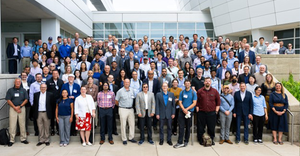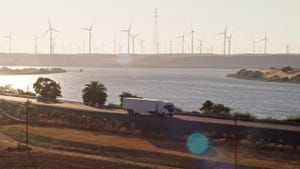Roadmap for Recovery
October 1, 2003
Bill Wolpin
UNLIKE THE FITS AND STARTS the U.S. economy has endured in the past decade, there always has been a consistent flow of garbage. To manage the loads, the industry has made vast improvements in waste management techniques. And today, leaders continue to stretch in new directions to raise the national diversion rate.
According to the Solid Waste Association of North America (SWANA), Silver Spring, Md., data from the U.S. Environmental Protection Agency (EPA) indicates the nation's overall reduction and recovery rate in 2000 was higher than 50 percent, when taking into account all forms of source reduction, recycling, composting and energy recovery. Yet not one to rest on its laurels, SWANA recently created a strategy to further increase municipal solid waste recovery and reduction efforts. This plan is outlined in an amendable document, “Pushing the Envelope on Waste Reduction and Recovery,” and is designed to help create policy recommendations that remove barriers to achieving higher diversion goals.
If the industry does not create incentives to reduce waste and recover more, it will be difficult to increase the overall national reduction and recovery rate to 65 percent, according to SWANA. Thus, at the heart of the strategy are six recommendations for federal, state and provincial policymakers:
Encourage more extensive product stewardship by product designers, manufacturers, retailers and consumers;
Expand efforts by federal, state and provincial governments to develop markets for recycled materials and recovered energy;
Provide financial incentives for investments in recycling, composting and the use of recycled materials;
Include waste-to-energy (WTE) and conversion technologies in renewable portfolio standards and green power programs.
Encourage the recovery and use of landfill gas by reinstating federal tax credits and through renewable portfolio standards and green power programs; and
Support technology transfer and research and development efforts that have the potential to significantly increase waste recovery rates, as well as work to reduce barriers to their implementation. [To view the strategy in its entirety, visit www.swana.org.]
The tasks will not be easily accomplished. But SWANA expects to modify its strategy based on comments it receives and then use the recommendations in advocacy efforts. In effect, the document is a starting point to stimulate discussion, SWANA says. Waste Age recently began the dialogue with SWANA's Executive Director and CEO, John Skinner.
WA: Why did SWANA create a strategy to increase solid waste reduction and recovery?
Skinner: As a leading professional association in the solid waste field, we believed SWANA was in a unique position to set a vision for reaching higher levels of municipal solid waste recycling and recovery in North America. We also felt it was important to describe the gains that have been made in the past decade in increasing waste reduction and recovery levels. No matter which aspect of integrated solid waste management you look at — source reduction, recycling, landfill gas recovery, waste-to-energy or composting — recovery levels have been increasing across the board. Waste management professionals can take pride in the world-class solid waste recovery and reduction systems that have been put in place across North America. The recommendations set forth basic policy initiatives that are necessary to “Push the Envelope” to even higher levels.
WA: How did the strategy develop?
Skinner: We used a very inclusive process starting with a working group of representatives from our eight technical divisions. Each division has several hundred members that focus on a specialty area (i.e., recycling, landfill gas recovery, waste-to-energy, etc.). Together, the divisions formulated the strategy and developed a draft, which was sent to the 46 SWANA chapters in the United States and Canada. We incorporated many comments from SWANA members. The final version was unanimously approved by the SWANA International Board of Directors at its annual meeting.
WA: How is the strategy being communicated?
Skinner: We are presenting the strategy every chance we get at chapter meetings, regional symposia and national conferences, including the U.S. Environmental Protection Agency's (EPA) RCRA (Research Conservation and Recovery Act) national meeting. Key to our communications plan will be to introduce some of these ideas into the mainstream media by linking them to some broader issues that are currently getting a lot of media play, such as homeland security, energy independence and job creation. Copies also have been sent to all 7,000 SWANA members, and a copy can be downloaded from our Web site.
WA: How is the strategy a “living document?”
Skinner: Each of the policy recommendations plants the seed of an idea that needs to be developed further. For example, in the area of product stewardship, [we need to determine] which products [should be developed] and how they should be managed. What type of financial incentives for recycling [should be developed] and who should receive them? What research and development (R&D) should be carried out? As we work through the answers to these questions, the strategy will grow and become more elaborate. We also will add new ideas and concepts that might come from our outreach efforts.
WA: How often will the strategy be modified?
Skinner: The strategy will establish the framework for SWANA's legislative and regulatory advocacy, and for our public outreach and communication efforts for the next three to five years. As we develop it further and obtain new ideas, it will be modified just as it was originally developed, working through our technical division, chapters, members and board.
WA: What barriers prevent an increase in solid waste reduction and recovery?
Skinner: There are technical barriers. For example, some products are difficult to recycle because of their design. That is why it is important to encourage more product stewardship by product designers and manufactures, including programs to collect, process and recycle products when they are discarded.
There are economic and market barriers as well. Virgin materials have benefited from subsidies and tax incentives to encourage their development and use, in lieu of recycled materials. That's why it's important to explore similar financial incentives for recycled material use.
There also are cost constraints. Quite often, local governments find it difficult to justify expenditures for waste recovery in the face of budget deficits and other pressing revenue needs. SWANA believes that local governments should be provided with a wide range of recovery options so that they can select what works best for them in the most economical manner.
WA: Describe this “wide range of reduction and recovery options.”
Skinner: If you take a comprehensive view of solid waste recovery and reduction, the options are only limited by our ingenuity. Recycling levels can be increased by employing new techniques, such as single-stream recycling combined with automated collection. Composting can be expanded to include food wastes, animal carcasses and mixed organics. Landfill gas can be used as a fuel in industrial furnaces, in engine-generator sets to produce electricity, to power vehicles when converted to compressed or liquefied natural gas, or to drive fuel cells. WTE plants can provide clean, renewable power. Old landfills can be mined to recover materials or fuel. On the R&D horizon, there are a number of promising new thermal, chemical and biological conversion processes that can be used to convert solid wastes into industrial biochemicals and fuels. The options are out there, you just have to think beyond recycling bottles, cans and newspapers.
WA: I understand why we should address waste generation along with recovery, but why use the “Waste Reduced and Prevented” number in your calculation, when the waste generated is real and the other isn't (an apples and imaginary oranges concept)?
Skinner: Whatever you call it — waste reduction, source reduction or waste prevention — it is always at the top of the waste management hierarchy but remains difficult to quantify. How do you account for waste that was never produced in the first place? The EPA estimated this amount at 55 million tons in 2000. This resulted from real actions including the manufacture of smaller and lighter products, home composting and grasscycling. If these activities did not occur, we would have landfilled an additional 55 million tons of waste. However, because of the apples that we recovered, along with the oranges that we never produced, we landfilled 9 percent less than we did in 1990. Since the waste reduction figures are included in both the numerator and denominator, you never reach 100 percent.
WA: How will SWANA work with others to increase recovery and waste reduction?
Skinner: One of the policy recommendations is for federal, state and provincial policy-makers to develop a series of financial incentives for investments in recycling, composting and the use of recycled materials. To implement this recommendation, SWANA wants to establish an alliance of organizations that would work toward developing legislative proposals. We envision an alliance of broad-based organizations that would support the concept of creating financial incentives to increase recycling nationally. These organizations would be asked to participate in a multi-year advocacy effort for a federal legislative proposal that also may be used as a model for state or provincial initiatives.
WA: How can our readers get involved in this effort?
Skinner: I hope they will join SWANA in developing a Recycling Incentives Alliance and help to develop meaningful financial incentives that will lead to higher levels of recycling and composting.
People also can walk the talk. By that I mean to take action to encourage waste reduction and recovery in their lives. People can buy products containing recycled materials, or purchase electricity from companies that offer green power derived from solid waste. They also can make sure that they practice recycling in their homes and businesses.
To kick off the alliance, we will be inviting representatives from local and regional governments, professional and trade associations, and industrial, environmental and public interest groups to a workshop on Oct. 13, 2003, in St. Louis, to be held in conjunction with WASTECON, our conference and exposition. To learn more about this workshop, e-mail: [email protected].
Bill Wolpin is Waste Age's Editorial Director.
You May Also Like


